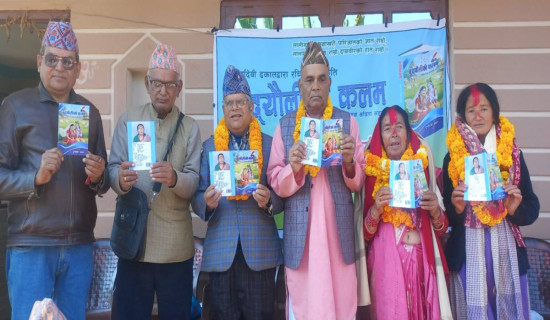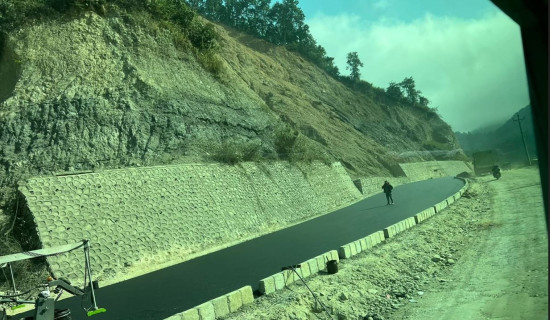- Sunday, 14 December 2025
Battle Over Basmati
Rakshya Khanal
Geographical Indication
GI is an indication, which identifies a good as originating from a certain region or locality where a given quality, reputation or other characteristics of the good is essentially attributable to its geographical origin. The products, for example, Palpali Dhaka, Gundruk Pokherali Jethobudo, Nepali Kagaj etc. derive certain qualities from their place of production and that attribution is attached to having a specific location, or geographical factors such as climate and soil temperature. These factors make them qualified to be protected under Geographical Indication.
Geographical Indication offers the consumer with informed choice, thereby genuine purchasing decisions. It offers recognition of intrinsic value, including social, cultural, spiritual, economic, scientific, intellectual, commercial and educational values that the cultural community consider to have been included in heritage. Distinctive signs and reputation, which denote the persistence of quality, plays an important role in signalling a certain level of quality, thereby promoting local and external market.
Failure
Despite witnessing the rapid emergence of GIs as one of the most significant tools to protect the product, the quality of the product that is associated with geographical origin, the reluctance at the legislative level is now threatening the existence of these products in Nepal. A Bill on Industrial Property, 2077 is lingering around somewhere in parliament; unaddressed and unnoticed. The lack of specific legislative protection for the Geographical Indication of Nepal has dragged Nepal's Intellectual Property into domestic and international concerns. However, there exists abundant potential and scope for the protection of GI to protect both producer and consumer rights.
Though IP policy 2073 addresses some of the emerging issues relating to GI, the provisions are insufficient to address the growing need and provide effective protection.
Nepal is rich in resources and products that are capable of being protected under GI. Amid these potentials and possibilities, Nepal is still lagging way behind in terms of recognition and protection and the major problem lies in search and research.
There has been a lack of substantial research investment in this sector that is pulling these products from being tradable not just in national territory, but also in the global market. Due to the lack of procedural and legal arrangements for the registration of marks, there exists a problem in promoting Nepali products in the national and international markets with their original qualities, characteristics and identity.
There is also a need to provide immediate service by fulfilling the demands and desires of the entrepreneurs regarding the arrangement for the protection of products and services originating from a specific location and having quality attached to the location. Since the country has no specific laws to protect GIs, further delay in adopting and enacting such legislation may cause intentional or unintentional theft of Nepal’s IP. For instance, India could strongly secure GI of the products that originate from both India and Nepal.
An example of this can be India claiming Mithila paintings, which have origin in Janakpur, as its own by naming them 'Madhuwani Painting'. The GI of Madhubani Paintings has been registered in India as handicraft good under class 16 and Geographical Area Bihar.
Also, Nepal cannot obtain protection for its goods in a foreign country having GI laws in place unless it provides intellectual property protection in its territory. Pakistan has decided to register Himalayan Pink Salt (what we call “Birenun” in Nepal) as GI to prevent its unauthorized use by other countries.
Pink Salt originates also in Nepal and once Pakistan acquires international registration with exclusive rights, Nepal will be disabled to distribute it in the national and international market as a Nepalese Product. Despite being a country with valuable natural resources, traditional knowledge and genetic resources having the potential of being protected by Intellectual Property Laws, the legal protection of GI in Nepal is weak.
Better Late than Never
The government should be alarmed for research and development in the existing situation of GIs with regards to their commercial viability in the global market to firstly protect them through GI and secondly prevent them from infringement.
Documentation of the possible products and recognition of traditional knowledge is a must in the quest for the protection of GI. The government can enter into negotiation and collaboration with producers, communities and concerned stakeholders. Collaboration with producers and stakeholders. The first step is that the stakeholders including the government, local level and producers, should collaboratively adopt an exploration of the product that has the potential of being recognized as a Geographical Indication. This may help to limit the risk of the indication becoming a generic term.
At the institutional Level, Nepal can establish a mechanism to look after the GI issues and secure GI rights on the products which originate from Nepal or are manufactured here. A department can be set up in a geographic location which needs protection to monitor and supervise the doings of the exploiter of the product. The government can come up with a policy where there would be an agreement between the community and the exploiter that the exploiter would, in no way violate the peculiarity and originality of that geographic area.
To create opportunities for prosperity through the promotion and protection of Geographical Indication, Nepal must make arrangements for the identification, acquisition, rights, unauthorized use of GI, treatment of infringement and fulfilment of obligations created by international treaties and agreements. There is a need to develop the necessary legal and institutional mechanisms.
There exist no separate bodies responsible for the protection of GI. As a result, since the protection, development and promotion of intellectual property have not been done effectively, the government must develop mechanisms to make maximum benefit by using intellectual property in national development.
Separate legislation is a must to make institutional and legal protection of GI to promote creativity in the country, protect the rights of creators, create an industry-friendly environment, attract foreign investment and technology, create employment opportunities and prevent counterfeit products and protect the interests of consumers as per national development priorities and international treaties.
Effective policy, legal, institutional and procedural arrangements are essential for the development, protection and implementation of intellectual property for economic, and social transformation through the creation of an industry-friendly environment, growth of foreign investment, creation of employment opportunities and technology transfer by promoting knowledge, skills and competencies in Nepal.
(Khanal is an advocated and holds a B.A. L.L.B degree. rakhyakhanal97@gmail.com)

















